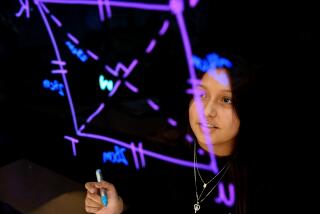In Rancho Bernardo, a new high...
When O’Farrell Junior High closed its doors in June, 1981, in Southeast San Diego, its reputation was that of a school with a rough environment, with more-than-occasional fights among students, and with test scores at or near bottom among all county schools.
When the new O’Farrell Middle School reopens next September--almost a decade later--the “Dream Team” hopes to sweep away the lingering image of an unpleasant, unattractive minority school by taking a radical new approach to education unique within the San Diego Unified School District, the nation’s eighth-largest.
The cadre of 11 teachers, librarians and clerical people call themselves “Team O’Farrell--The Dream Team” and their dream is indeed audacious--to eliminate traditional concepts regarding teaching and counseling of adolescents, the curriculum, and school governance.
In total, the staff wants to put into practice a host of educational reforms talked about nationally during the past several years, but attempted in a comprehensive fashion only in a handful of schools nationwide and with mixed results.
So far, their year of planning has produced plans to expose all students to a single advanced academic curriculum, with the assumption that all students can benefit from high expectations and the most rigorous material in history, math and English--no matter their background preparation and the different speeds at which they learn. Instruction will be carried out across broad interdisciplinary themes and by dividing students into “families” of 100 or so, where they will remain with the same group of teachers for all three years of middle school, composed of grades 6, 7 and 8.
In addition, the staff has decided, as a result of decision-making powers especially given by Supt. Tom Payzant, to put extra funds the school will qualify for--because of its largely minority population--into extra teachers, rather than additional equipment or counselors, to cut class size.
That means that much of the counseling and discipline normally done outside the classroom must be carried out by the teachers themselves, together with any assistance from parents and community groups they will actively solicit. But they believe the lower class size will allow them “to know all the kids, to be around them all the time,” in the words of principal Bob Stein, and thereby prevent most problems from getting out of hand.
The staff’s ambitious three-year goal is to assure that any student promoted from O’Farrell will be able to take the highest level academic courses at any high school in the city.
“This will not be a traditional school, and yes, we’re taking risks,” Stein said. “But all of us see too many schools that don’t work for kids. We want a school that does work for them, and we want teachers who feel the same way, who will approach schools differently, who want to have power to make decisions for helping children.”
The road is bumpy. The large school district bureaucracy has slowed planning at times, not so much intentionally but more because of a lack of experience in dealing cooperatively with an individual school, and in particular with one where the teachers want to turn things upside down.
But far more disturbing for Stein is that the dream team has not yet found a lot of colleagues convinced that educational reforms can take strong root in San Diego. Only one teacher out of almost 1,500 junior-high and middle-school instructors eligible to teach at O’Farrell responded last month to employment invitations for six additional positions.
In response, the staff has begun proselytizing for additional pioneers, manning a job booth at a mentor teacher conference last month and holding a barbecue reception for potential applicants this past week. They hope the tepid response so far comes from lack of familiarity with their plans, rather than a lack of interest and reluctance to teach voluntarily at the predominantly nonwhite, south-of-Interstate 8 schools, a longstanding district personnel problem.
“Otherwise, the dream could die,” Stein said. He emphasizes that the school needs teachers who are eager to work long hours, who will accept power-sharing with parents and community leaders, and who will forgo much of their summer vacation to write innovative curriculum--all part of school restructuring to give teachers more power but also more responsibility.
Stein recalled a phone call from one teacher last month who saw the job announcements and whose first question was what the start- and end-of-day bell times would be so he could plan a commute.
“I told him that with those priorities, he didn’t want to be at O’Farrell no matter the bell times,” Stein said.
Rather, Stein wants teachers like Lenore Smith, an English and art instructor at Pershing Junior High, who has spent much of her spare time in the past year poring over innovative programs at other schools nationwide, and talking with colleagues about ideas to borrow for the classroom and how to grab the attention of the O’Farrell community, situated in the Skyline area of Southeast San Diego.
The school itself is a single-story junior-high style campus, typical of those built throughout San Diego during the late 1950s and early 1960s, except that its foundation has sunk in many places because the concrete foundation, poured over an adobe base, was not allowed to dry before construction began. Extensive reconstruction planned for the reopening can only partially compensate for the problem.
“I guess what drives us more than anything is that we all have a real sincere love of children and a real belief that personal contact with children at (this) age will promote their success if they know that someone cares for them, is watching out for them, and is pushing them,” Smith said.
The original team also includes Byron King, a well-respected former math teacher at Bell Junior High and district race-human relations counselor who participated in a special district interdisciplinary institute last summer to teach more creatively.
King agrees with Smith that the “battle of attitudes” with the children will be crucial in setting the school’s tone.
“The students have to believe in themselves that they can succeed--not that all will go as far as others--but that their educational experiences are not based on assumptions about their limitations,” King said. King’s own experience at Bell in helping the math department to move almost all students into algebra by the ninth grade--something that no one believed was possible--helps drive his sense of mission. Bell is the largest junior high west of the Mississippi and has an almost 80% nonwhite enrollment.
“We’ve got to prepare the students for what we are calling the ‘O’Farrell Way,”’ King said. “If we get this across successfully in the first six weeks of intense pounding, in affecting behavior of kids caring for each other, and of adults caring as well, then I think we create the ability to learn fast and efficient.”
King has been among the teachers recruiting students for the first class in September, which will open with only seventh-graders. Because of the district’s many magnet and voluntary busing options as part of its integration program, students at elementary schools near O’Farrell do not necessarily have to attend the new middle school.
So King last week took an example of what an interdisciplinary lesson might be like to sixth-graders at Fulton Elementary, by toting a skateboard.
“I pulled out the skateboard and started asking questions, like how would we measure the radius of the turn it makes, and why does one wheel spin faster in a circle than another, and what about the materials that make the price so cheap, and who invented the polymers used in making the wheels?” King said. “It’s a way to show them that we can learn not only in (traditional) ways but also in ways that they have experienced.”
He also asked them to think about what kids did before skateboards, about why some models become status symbols, about why school principals don’t like the things on campuses.
“You find too often that students are not prepared these days to ask inquisitive questions,” King said.
Added Stein: “He was hyperventilating after the presentation, he was so keyed up, and the students were so keyed up.”
The veteran member of the staff is Joe Nierodzinski, an industrial arts teacher for the past 34 years in San Diego.
“I’m one of those old-timers who believe you can have enough things at schools to keep kids motivated and moving, and can also use to teach other subjects,” Nierodzinski said. “When I teach drafting, I show kids how it fits into geometry and into the formulas they learn that they don’t see any need for . . . such things are the job of all good teachers.
“And this is what the new O’Farrell can be like. I’ll have a class make a bicycle and then Byron can show the kids how they can understand ratios by rotating and counting the gears on a revolving bicycle crank.”
For Nierodzinski, the team’s enthusiasm is key to his participation.
“You know, after 34 years in teaching, you see a lot, and in the back of my mind, I think about the fact we may be shoveling you-know-what against the tide,” he conceded. “But on the other hand, I thought it would be neat to go out with a bang, with a bunch of highly motivated, enthused people who help you stay young.”
More to Read
Sign up for Essential California
The most important California stories and recommendations in your inbox every morning.
You may occasionally receive promotional content from the Los Angeles Times.










